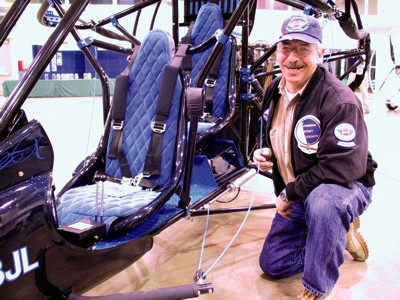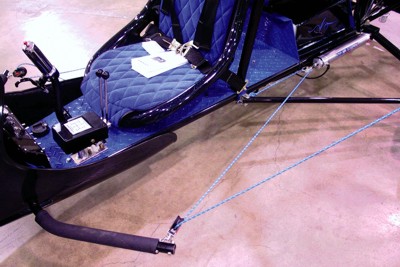One innovative designer offers an alternative to foot-controlled powered parachute flight.
For those of you that don’t know, most powered parachutes are steered around the sky using your legs. Pushing with your right leg exerts downward force on a steering line routed to the right trailing edge of the canopy/wing, producing drag on that side and initiating a turn in that direction.


Call It Power Steering
While Para-Ski has its handlebars, a measure of physical effort is still involved. Leon’s system involves a couple of air cylinders that move the lines as commanded by hand movement of levers placed adjacent to the single joystick. According to Leon, such hand controls can be taught to persons without full use of their legs.

According to Leon, his system uses “the best cylinders, control valves and certified air tank that we could find.” The system has a pressure relief valve, air regulator, gauge and onboard compressor, which he says “draws very little amperage.”

The air steering system costs $1500 installed including all hardware items.
Other Unique Products
Leon owns The Ultralight Place and operates the company from the Greater Kankakee Airport. At the time of this writing, the company just received word that it had earned the designation as the first ultralight operation to acquire an FBO status at the airport. Leon is quite an inventive fellow, and his company features several other interesting products in his catalog. In fact, another of his inventions serves to allow the hand steering controls to work more efficiently.
Since 1996-a relative eternity in the young powered parachute industry-The Ultralight Place has been selling its single stick control.

Leon says he can rig the throttle either way. Buckeye Aviation uses the joystick throttle as a regular joystick; you pull aft to add power and climb and push the joystick forward to slow the engine and descend. Some pilots, myself included, find this counterintuitive to our conventional training (throttle forward means more power, not less) but beginners reportedly adapt quickly. Since Leon will link the throttle whichever way you wish, pilots used to advancing the throttle by pushing forward on the joystick may feel more comfortable.
Another product dating to 1996 is Leon’s louver system, which incrementally closes airflow through the coolant radiator. Pilots in colder climates can help their engines warm up faster, though Rotax representatives say the coolant flow through the engine is adequately regulated in flight. As with all his other products, Leon’s electrically powered louver system is beautifully executed. A kit for the system runs $40 plus the actuating cables needed to move the vanes.
In addition to products for powered parachutes, Leon’s company offers specialty products for fixed-wing aircraft. The company offers a cabin heating system that supplies 70-80° F forced air for $300, a welcome addition for any pilot who flies in colder climates. Leon also makes a complete fuel filler system including flip-up filler cap, mounting bracket, hoses and connections; it sells for $125. Other fabricated components include battery covers, custom-built instrument panels, brakes, fuel tank covers and custom-made wheelpants, which start at $100 each.
One interesting factory product on Leon’s beautiful Buckeye Breeze is the underwing-a surface that he is enthusiastic about, saying that it can noticeably improve a powered parachute’s overall glide performance.
NAFI Man
Many developers are not heavy users of the products they develop; engineering and piloting are different skills with different activities. But Leon is a builder and a user. His flight jacket has a large sewn-on emblem from the National Association of Flight Instructors (NAFI) recognizing him as one of their Master Instructors. He uses his specially built Buckeye, among other powered parachutes, to give lessons.
In addition to training, The Ultralight Place also offers ceramic and powder coating, TIG and MIG welding, and a Level-Four Rotax Repair Station.
But Leon isn’t just a powered parachute fellow-he represents fixed-wing aircraft like Flightstar and the WeTTrike weight-shift amphibian.
The Ultralight Place has a wide product and services line, but the company’s surprisingly thorough web site will walk you through it all. In addition, the site provides general flying advice on a variety of topics, and most pilots will probably find something informative to read.
An affable fellow, Leon’s polished-to-perfection custom Buckeye Breeze was fitting evidence of his remarkable workmanship. It made me want to buy hardware from him-and I don’t even own a powered parachute! Hmmm, maybe that ought to change?
FOR MORE INFORMATION, contact The Ultralight Place at 815/529-3000 or visit www.theultralightplace.com.
This article was originally published in Kitplanes Magazine


Leave a Reply